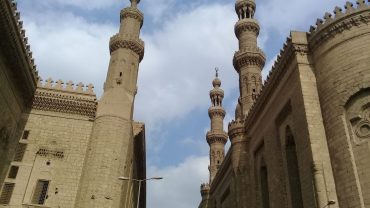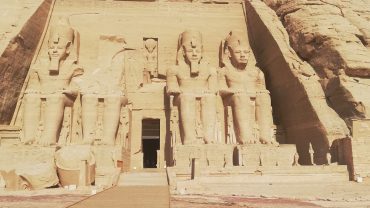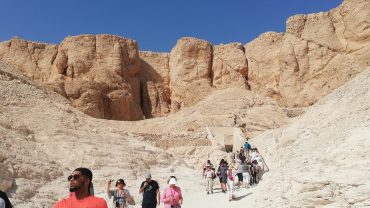The great pyramid, the largest and oldest of the group at Giza. It was built by command of the pharaoh Khufu, the second king of the forth dynasty. The name of the king is written in red upon the blocks. This pyramid was built to serve as the eternal home of the king and was named Akhet Khufu which means the horizon of Khufu.
This structure marks the zenith of the old kingdom architectural art, which for masterly execution and finish, attained a level that has rarely been equaled anywhere else.
Great pyramid of Egypt
Of Cheops life history nothing is known, but his native town was Menat Khufu, a town which lay about 225 km south of Cairo. He was more powerful than any king before. We can appreciate how strong and effective mist have been the organization of his government when we look at the gigantic structure of his pyramid.
He did nothing and had no war in any country but devoted himself entirely to the building of his great funerary monument. Cheops ordered to be constructed a pyramid that surprise all the others in size and grandeur and accuracy of execution.
It is said that an order was issued to the effect that each and every one in the state, even princes and nobles, should work for the king. This is however probably an exaggeration. More reasonable is the statement of Herodotus that an army of men, numbering 100,000 was employed for a period of three month every year.
During the other nine months, some 10,000 quarry-men were busy extracting the stone for the mighty structure. That for the core masonry was quarried locally, but the casing stone of fine white limestone came from Mokattam Hills, at Turah and Massarah, and were floated across the Nile on rafts at the time of the inundation, when the flood water extended up yo the very foot of the pyramid plateau.
The thousand men were divided into gangs, each gang having its own distinctive name. Foremen controlling these gangs in the quarries registered everything, and each block of stone was duly marked with sign denoting the name of the quarry and was the gang of quarry men and its place in the pyramid.
Herodotus related that the provisioning of the workmen was undertaken with great care and estimates that a sum equal to LE 350,000 of modern currency was spent upon the radishes, onions, garlic, and lentils. If this is true, how much more must have been spent upon other essential things, such as tool equipment and the maintenance and clothing of the workers.
The site chosen by Khufu was on the edge of an escarpment overlooking the Nile valley. It was a commanding situation and the stone in the immediate neighborhood was of particularly good quality and suitable for the core masonry of the pyramid. The granite with which the inner chamber was lined, would be brought from Aswan.
The work was commenced, but the name of the chief architect, a man worthy of being ranked with Imhotep as one of the greatest architects of all time, has unfortunately not been recorded in his history.
First of all it was necessary to construct a gangway over which the giant blocks could be dragged from the rafts on the Nile, up to the spot where the building was proceeding. This in itself was mighty labor, and Herodotus records that ten years were required to build the gangway. It measured 955 meters by 18 meters and its elevation at the highest point was 15 meters. It was entirely built of blocks of dressed limestone.
The construction of the actual pyramid covered a period of twenty years. According to a fresh survey undertaken by the official authorities, the measurements of this monument are as follows. The structure covers an area of 52610 square meter, the length of each side of its square base is 50 meter, and its present height is 137 meter. The length of the sloping side, which incline at an angle of 51.52 degrees, is 236 meter, and was originally about 9 meter more. At the summit is now a flat space, about 9 meter square. In its original state the pyramid would have been crowned by a pyramidal cap-stone, probably of granite or some other hard stone.
There is no doubt that all the resources of the country were completely at Khufu’s disposal and under his control. He kept within the royal house all the principal offices of state, his sons were in charge of all the most important affairs of the kingdom, such as collecting and supervising revenues, controlling quarries, and this was the general policy of the pharaohs of the old kingdom.
The monument is said to be composed of about 2.300.000 limestone blocks, each of which is not less than 1.3 cubic meter and averaging some two and a half tons in weight and reaching a maximum of fifteen tons. The casing blocks are so perfectly joined that the joints can hardly be detected.
The mathematical precision of the construction is an object of amazement to engineers and architects of the present day, moreover, it is estimated that to build such a pyramid nowadays, using the very latest mechanical and architectural methods, would cost millions and require more than ten years.
The original entrance to the pyramid is not at present accessible, but it may be seen, marked by its diagonally laid roofing slabs, on the north face above the present entrance. The entrance which we use today is in reality a forced hole made by treasure hunters, and is known as the passage of Maamoun, the son of Haroun El Rashid. This passage is about 14 meter from the ground level, and is situated in the thirteenth layer of masonry.
The Giza pyramids were opened by the Persians during the 5th and 4th centuries before Christ, and it is probably that they were also entered by the Romans. The Khaliph Maamoun entered the great pyramid and found that others had been there before him. The treasure which is said to have been discovered there by him is probably fictitious. Once opened, it must have been evident to everyone that these pyramids are used only as tombs.
The interior of the pyramid is practically all solid masonry, except for a series of passages, halls, and rooms, which occupy but little of the massive bulk of the structure.
Traversing the robbers’ tunnel for 18 meter, we enter a narrow stone corridor which rises steeply into the pyramid for about 115 meter. Here we come to the great pyramid gallery, a marvel of skillful engineering. The gallery is 44 meter length and 5.g meter in height. Its walls of polished limestone rise vertically to a height of 2 meter. The roof is formed be seven courses of massive masonry, each course projecting inwards for 0.076 meter, so that the width of the walls diminishes and forms a kind of false vault.
At the commencement of the grand gallery, a horizontal passage leads to the so called queen’s chamber which is not able for care shown in its construction. The queen’s chamber measures 5 by 5.5 meter. It has painted roof which rises to a height of 6 meter.
Returning to the grand gallery, we begin to ascend. This gallery, up which the king’s mummy had been drawn to its last resting place, has been fitted with modern steps and handrail. The parallel grooves cut in the floor were made to facilitate the transport of the sarcophagus.
Visit Giza pyramid from Hurghada
Wonder at the Pyramids of Egypt, book a day trip and see the top glory of Egypt.
The grand gallery ends in a small, horizonal narrow passage, 6.7 meter long by 1 meter high, expanding in the middle into an antechamber, which was once skillfully closed by means of four portcullises, each formed by a huge, single block of granite.




Comment (0)